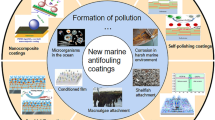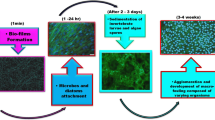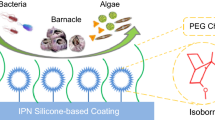Abstract
Antifouling coatings are used to improve the speed and energy efficiency of ships by preventing organisms, such as barnacles and weed, building up on the underwater hull and helping the ships movement through the water. Typically, marine coatings are tributyltin self-polishing copolymer paints containing toxic molecules called biocides. They have been the most successful in combating biofouling on ships, but their widespread use has caused severe pollution in the marine ecosystem. The low surface energy marine coating is an entirely non-toxic alternative, which reduces the adhesion strength of marine organisms, facilitating their hydrodynamic removal at high speeds. In this paper, the novel low surface energy non-toxic marine antifouling coatings were prepared with modified acrylic resin, nano-SiO2, and other pigments. The effects of nano-SiO2 on the surface structure and elastic modulus of coating films have been studied, and the seawater test has been carried out in the Dalian Bay. The results showed that micro-nano layered structures on the coating films and the lowest surface energy and elastic modulus could be obtained when an appropriate mass ratio of resin, nano-SiO2, and other pigments in coatings approached. The seawater exposure test has shown that the lower the surface energy and elastic modulus of coatings are, the less the marine biofouling adheres on the coating films.
Similar content being viewed by others
References
Nikolaos Voulvoulis, Scrimshaw M D, Lester J N. Comparative environmental assessment of biocides used in antifouling paints. Chemosphere, 2002, 47: 789–795
Alzieu C. Impact of Tributyltin on Marine Invertebrates. Ecotoxicology, 2000, 9: 71–76
Hellio C, Broise D D L, Dufosse L, Gal Y L, Bourgougnon N. Inhibition of marine bacteria by extracts of macroalgae: Potential use for environmentally friendly antifouling paints. Mar Env Res, 2001, 52: 231–247
Negri A P, Hales L T, Battershill C, Wolff C, Webster NS. TBT contamination identified in Antarctic marine sediments. Mar Poll B, 2004, 48: 1142–1144
Champ M A. A review of organotin regulatory strategies, pending actions, related costs and benefits. Sci Total Env, 2000, 258: 21–71
Matthiessen P, Law R J. Contaminants and their effects on estuarine and coastal organisms in the United Kingdom in the late twentieth century. Envir Poll, 2002, 120: 739–757
Diez S, Abalos M, Bayona J M. Organotin contamination in sediments from the Western Mediterranean enclosures following 10 years of TBT regulation. Water Res, 2002, 36: 905–918
Whalen M M, Green S A, Longanathan B G. Briefbutyltin exposure induces irreversible inhibition of the cytotoxic function on human natural killer cells in vitro. Env Res, 2002a, 88: 19–29
Champ M A, Published in the Proceedings of the 24th UJNR (US/Japan) Marine Facilities Panel Meeting in Hawaii, November 7–8, 2001
Mirabedini S M, Pazoki S, Esfandeh M, Mohseni M, Akbari Z. Comparison of drag characteristics of self-polishing co-polymers and silicone foul release coatings: A study of wettability and surface roughness. Prog Org Coat, 2006, 57: 421–429
Casse F, Swain G W. The development of microfouling on four commercial antifoulingcoatings under static and dynamic immersion. Int Bio Bio, 2006, 57: 179–185
Finlay J A, Callow M E, Schultz M P, Swain G W, Callow J A. Adhesion strength of settled spores of the green alga Enteromorpha. Biofouling, 2002, 18: 251–256
Holland R, Mdugdalf T, Wetherbee R, Brennan A B, Finlay J A, Callow J A, Callow M E. Adhesion and motility of fouling diatoms on a silicone elastomer. Biofouling, 2004, 20(6): 323–329
Luca Tiano, Donatella Fedeli, Giorgio Santoni, Ian Davies, Giancarlo Falcioni. Effect of tributyltin on trout blood cells: Changes in mitochondrial morphology and functionality. Biochim Biophys Acta, 2003, 1640: 105–112
Statz A, Finlay J, Dalsin J, Callow M E, Callow J A, Messersmith P B. Algal antifouling and fouling-release properties of metal surfaces coated with a polymer inspired by marine mussels. Biofouling, 2006, 22(6): 391–399
Walker G C, SUN YuJie, GUO SenLi, Finlay J A, Callow M E, Callow J A. Surface mechanical properties of the spore adhesive of the green alga ulva. J Adhesion, 2005, 81: 1101–1118
WANG XianMing, WANG HuaJin, WANG Li, LIU DengLiang. Non-toxic low surface energy antifouling coatings. Paint Coat Ind (in Chinese), 2004, 34(1): 40–43
Robert F. Brady Jr. A fracture mechanical analysis of fouling release from nontoxic antifouling coatings. Prog Org C, 2001, 43: 188–192
Yebra D M, Kiil S, Kim D J. Antifouling technology-Past, present and future steps towards efficient and environmentally friendly antifouling coatings. Prog Org C, 2004, 50: 75–104
Anderson C, Atlar M, Callow M, Candries M, Milne A, Townsin R L. The development of foul-release coatings for seagoing vessels. J Mar Des Op, 2003, No. B: 11–22
QU YuanYuan, CHEN MeiLing, GAO Hong. Low surface energy antifouling coating of organosilicon modified acrylate/nano-SiO2. New Chem Mat (in Chinese), 2006, 34(8): 40–42
Barthlott W, Neinhuis C. Purity of the sacred lotus, or escape from contamination in biological surfaces. Planta, 1997, 202: 1–8
LU JiaLin, ZHANG BaoHua, LI DeFang. Development of dispersion research on SiO2 nano-coatings. Shanghai Chem Ind (in Chinese), 2004, 12: 33–35
Author information
Authors and Affiliations
Corresponding author
Additional information
Supported by High-Tech Research and Development Program of China (Grant No. 2004AA001520)
Rights and permissions
About this article
Cite this article
Chen, M., Qu, Y., Yang, L. et al. Structures and antifouling properties of low surface energy non-toxic antifouling coatings modified by nano-SiO2 powder. Sci. China Ser. B-Chem. 51, 848–852 (2008). https://doi.org/10.1007/s11426-008-0069-5
Received:
Accepted:
Published:
Issue Date:
DOI: https://doi.org/10.1007/s11426-008-0069-5




